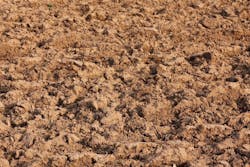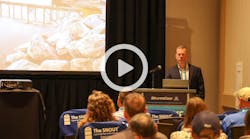Caltrans & CSU, Sacramento Team Up for RUSLE Software Application
John Gleason. is. PE, CPESC, QSD, TOR at M.S. Hatch Consulting, LLC. Gleason can be reached at [email protected] and Hamid Hakim is PE for Caltrans Division of Construction. Hakim can be reached at [email protected].
undefinedThe storm water industry in California needs a software application that will easily determine the soil loss (erosion) to compare pre-construction conditions to post-construction conditions to meet final stabilization requirements.
This may be especially needed with the recent draft of the General NPDES Permit for storm water discharges from construction activity (NPDES No. CAS000002) (CGP) that appears to require additional use of RUSLE. California users have been using the RUSLE2 program with limited success to document post-construction finalization to the satisfaction of the regional water boards.
Caltrans has recently teamed up with Cal-State University Sacramento master’s program to develop a RUSLE software application. The application is a transparent alternative to the RUSLE2 program to comply with the requirements of the CGP. The CGP requires use of RUSLE as an option for terminating permit coverage demonstrating final stabilization for post-construction is less than or equal to the pre-construction erosion potential.
The basis for the application is the Revised Universal Soil Loss Equation (RUSLE):
A=R x K x LS x C x P
Where:
A = soil loss in tones/acre/year
R = erosivity (based on schedule and rainfall intensity)
K = erodibility (based silt content of soil)
LS = length/steepness (based on representative slope length and steepness)
C= cover management (BMPs based on cover effectiveness)
P= erosion control practice (other erosion control BMP effectiveness)
This RUSLE software application goal is to compare pre- and post-construction conditions for the purpose of meeting final stabilization for CGP termination. The application had to have the features discussed below to meet that goal.
Both pre- and post-construction calculations need to have representative subsites (segments, representative areas) that would be based on acreage percentage of the entire project [similar to RUSLE2 transect] and feed into a single pre- or post-construction annual erosion or soil loss in tons/acre/year. There may be several inputs for representative areas on a construction project that are weighted by representative area.
Although the erosivity (R factor) for a pre-and post-construction comparison will not change on an annual basis, it is included to have realistic erosion values. The application will include a link to the EPA calculator similar to the California Storm Water Multiple Application and Report Tracking System (SMARTS), which most California users should be familiar with. In order to compare annual soil loss or erosion (tons/acre/year), the schedule for the erosivity calculator should be one full year. The users will be directed to input an entire year in the schedule for the annual erosivity and use it for both pre- and post-construction annual erosion calculations.
The soil erodibility (K factor) may change during construction and will be input by the user. The user will be directed to input the K factor from the SMARTS default unless a site-specific K factor is calculated from samples at the site using ASTM D-422. The post-construction K factor may be different if there is fill or the site surface is excavated. The K factor source reference will be input based on site-specifics. The K factor will also require a percentage input based on acreage represented. If soil at the site changes silt content in portions of a site, the application has to account for it by including multiple K factors for subsites with the acreage percentage they represent.
The LS factor would be based on a table of length versus slope percent that is used in the CGP. The user will input slope length and steepness (slope percent) for representative areas with associated acreage percentage. The subsites will allow for multiple entries. The application will use the CGP table to convert length and slope percentage (steepness) entries to LS factors.
The application will include a list of cover BMPs with C factors and references. Examples include hydroseed, landscaping, bonded fiber matrix, pavement, gravel, other spray applications, etc. The initial list was limited as C factors were not specifically available for many BMPs. However, the application accepts user-input BMPs with C factors and references. The added BMPs will allow the application to build its database. The user will input the BMPs and their respective acreage representation. Any user inputs will be kept in an unapproved list until verified by the software administrator, but once approved, additional BMPs will be available to all users.
The P factor practices will also have a list of BMPs with P Factors and references with a percentage of area represented. Examples include track walking and fiber rolls. Additional BMPs may be added with P factors and references for temporary use until approved by the software administrator.
It is important that the K, LS, C and P can have multiple entries for each subsite. A weighted average for each factor would be used for each subsite. The subsites would also be weighted into the entire project RUSLE factors to calculate the project erosion.
The application will compare pre- and post-construction erosion to determine whether the post-construction is less than or equal to pre-construction and meets the final stabilization requirements. In addition, the individual subsites will be calculated so if the goal is not reached, it will be apparent which subsite is causing the issue.
The RUSLE software application will have a reporting function. The report will be coordinated with the site map and photos required for the CGP Notice of Termination (NOT) to demonstrate that final stabilization is met. The locations and areal percentages for each subsite used will be shown on the sitemap required for NOT. In addition, the BMPs used in the application will have photos submitted with the NOT. The application report will show the total site disturbed area and the representative subsites with percentages that add up to the total. Each subsite will be reported with its BMPs, factors and covered percentages. The final pre-construction soil loss compared to post-construction soil loss will be shown.
The application report will be combined with the site map and photos for a complete package for upload to SMARTS. In addition, the long-term operations and maintenance plan will include a plan for maintaining the BMPs that demonstrate final stabilization until the site has met the final vegetation establishment or the 70% of pre-construction uniform vegetation cover insisted on by the water boards.
This is not just a replacement of the RUSLE2 program. This is to be more specific to the needs of California construction consistent with the CGP. However, the software application could also be used nationwide for the same purpose. The RUSLE software application will include typical construction BMPs that can be installed to meet the final stabilization requirements. This application is transparent so the water board or other reviewing agencies can see the BMPs, associated factors and references for verification. It is tied with use to the NOT requirements of the CGP, and the BMP references will be available for peer review. For example, Earthguard Fiber Matrix has assigned a C factor based on studies they performed and published in an online reference.
As more C factors are available for BMPs, they will be added to the application. The demo RUSLE software application is expected to be shared with the California Stormwater Quality Association (CASQA) and the California State and Regional Water Boards for review. Competing software applications are expected to improve on this outline for a simple and easy way to comply with post-construction standards.


